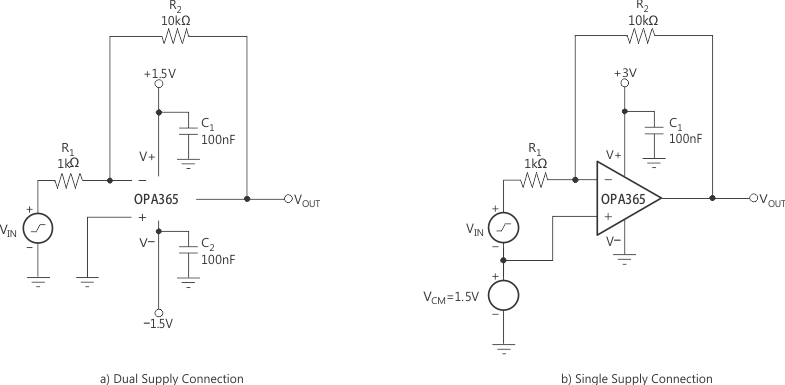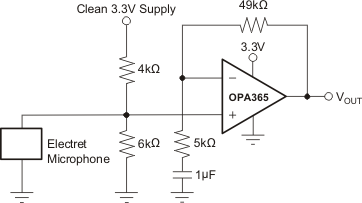SBOS512E March 2010 – November 2020 OPA2365-Q1 , OPA365-Q1
PRODUCTION DATA
- 1 Features
- 2 Applications
- 3 Description
- 4 Revision History
- 5 Pin Configuration and Functions
- 6 Specifications
- 7 Detailed Description
- 8 Application and Implementation
- 9 Power Supply Recommendations
- 10Layout
- 11Device and Documentation Support
- 12Mechanical, Packaging, and Orderable Information
Package Options
Mechanical Data (Package|Pins)
- DBV|5
Thermal pad, mechanical data (Package|Pins)
Orderable Information
7.3.2 Basic Amplifier Configurations
As with other single-supply operational amplifiers, the OPA365-Q1 may be operated with either a single supply or dual supplies (see Figure 7-1). A typical dual-supply connection is shown in Figure 7-1, which is accompanied by a single-supply connection. The OPA365-Q1 device is configured as a basic inverting amplifier with a gain of −10 V/V. The dual-supply connection has an output voltage centered on zero, while the single− supply connection has an output centered on the common-mode voltage VCM. For the circuit shown, this voltage is 1.5 V, but may be any value within the common-mode input voltage range. The OPA365-Q1 VCM range extends 100 mV beyond the power-supply rails.
 Figure 7-1 Basic Circuit Connections
Figure 7-1 Basic Circuit ConnectionsFigure 7-2 shows a single-supply, electret microphone application where VCM is provided by a resistive divider. The divider also provides the bias voltage for the electret element.
 Figure 7-2 Microphone Preamplifier
Figure 7-2 Microphone Preamplifier